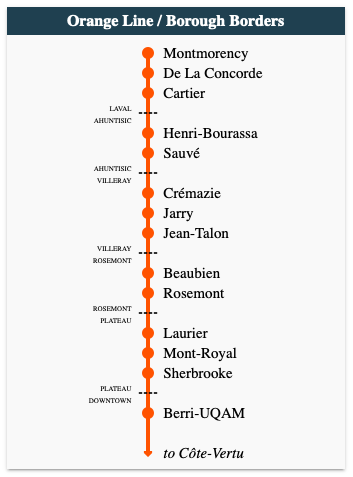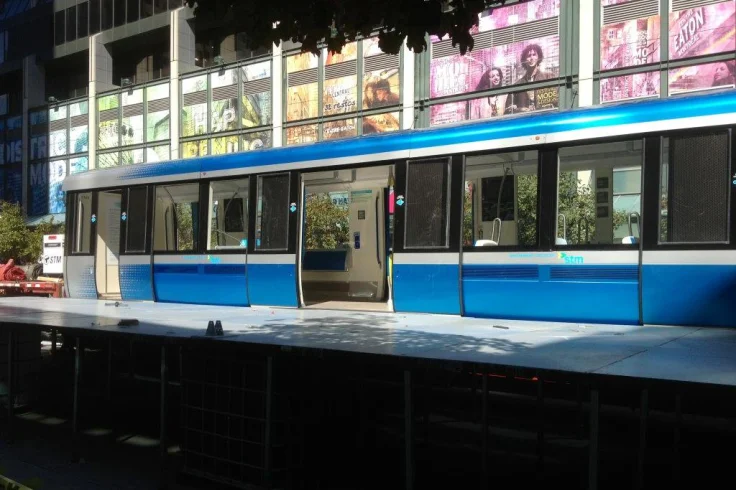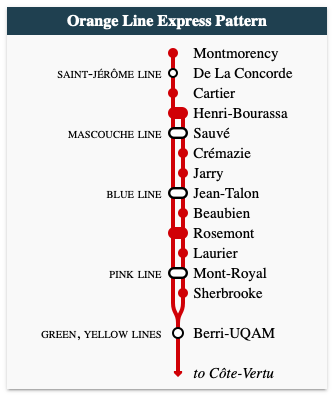
As any user of Montreal’s Orange Line will be able to tell you, it’s starting to become overcrowded, particularly on the Eastern branch. Will it improve or worsen? Let’s have a look.
There are two main challenges which await (or potentially await) the Orange Line over the coming years:
- The knock-on effect of the REM on the RTM’s Mascouche commuter train line
- The extra load from a Blue Line extension to Anjou
We’ll begin by looking at these two items in a bit more detail, and then try to understand what the impact will be on the Orange Line, particularly for those in the heavily used Eastern section between Jean-Talon and Berri-UQAM. After that, we’ll consider a few ideas which could help future-proof this Metro line for the challenges coming its way.

The REM Will Change Things
Most Montrealers should be familiar with the REM project, but for the unitiated, here’s what it’s all about.
The previous Quebec government pushed through a controversial light rail project to connect the suburbs and airport to Downtown. I won’t go into details of the controversy, as others have already covered this in excellent detail. But for the purposes of this post, you need to know the REM will take over an existing heavy rail commuter line (the Deux-Montagnes line) and cut off another commuter line’s access to Downtown (the Mascouche Line). A new transfer station will be added to connect the Mascouche Line and the REM, so passengers can complete their journeys downtown.
I wrote about the Mascouche Line a few years ago after it had just opened. There was much which bemused me about it then, and I now find myself even more perplexed. As the province plans to further stunt this extremely useful line, there appears to have been little thought or concern for the impact. My concern is the greatest load of the impact will be felt by the Orange Line’s Eastern arm.
As part of development along the Mascouche Line, an interchange of sorts was added between a new station at Sauvé and the existing Metro station of the same name. This demonstrated an unusual level of sensible transit planning for the province. By adding a new interchange between the Metro and suburban rail services, it provided commuters with a way of switching to the Metro without having to go all the way downtown.
However, with the Mascouche line no longer going all the way to the city centre, and commuters expected to switch to the new REM to complete their journey, many may instead choose to switch to the Orange Line at Sauvé. I suspect this is a likely scenario, as I see the REM trains arriving from the West Island and the airport fully packed, and not having much capacity left in them for the people who want to transfer off the Mascouche line.
The Blue Line Arrives
So, we’ve established that there may well be an additional influx of passengers on the section of the Orange Line North of Jean-Talon, but what happens if the Blue Line also gets extended?
The extension of the Blue Line to the East of Saint-Michel has been promised for a long time. But, there are positive signs that this will be the moment the project finally goes ahead. There’s obvious demand for it and it’s a no-brainer in terms of sensible transit planning.
Extending the Blue Line all the way out to Anjou will open the Metro to a large number of new users. Some of the new users will be those who’d normally drive downtown. Some may currently take a bus to the Green Line, but would now be located near a shiny new subway station.
This post doesn’t intend to look in detail at how additional capacity would be added to the Blue Line to cope with all these new users, but in summary I think the capacity could be easily found, provided the rolling stock is available:
- Trains are relatively infrequent compared to other Metro lines. Adding additional trains would increase capacity.
- Trains currently run as 6 cars, but platforms can accomodate 9 cars meaning existing timetabled services could carry up to 50% extra capacity.
All well and good. What’s not so good is the additional passengers wishing to go downtown will hop off at Jean-Talon, and transfer to the Orange Line. Add these passengers to the transferees from the Mascouche Line, and I suspect Orange Line services heading South from Jean-Talon would be at capacity, or close to it.
This doesn’t bode well for anyone wanting to catch a train between Beaubien and Sherbrooke.

The Plateau and Rosemont
The Plateau (or to give it its proper name, “Le Plateau-Mont-Royal”) is a dense neighbourhood. In fact, it’s not just Montreal’s densest neighbourhood, nor Québec’s. It in fact may be the densest neighbourhood in Canada (at least it was in 2011). In spite of this, the Plateau only has three Metro stations: Sherbrooke, Mont-Royal and Laurier, all of which are on the Orange Line.
The borough to the North, Rosemont–La Petite-Patrie, is one of Montreal’s most populous boroughs. It’s served by just two stations: Rosemont and Beaubien, again on the Orange Line.

Today, if you try and take a train from one of the aforementioned stations during the morning peak, you’ll experience a certain level of overcrowding when heading Downtown.
Rosemont–La Petite-Patrie borough residents are usually able to get on at Beubien and Rosemont. Laurier is a very popular station, and it can be much harder to push onto a train. People boarding at Mont-Royal and Sherbrooke often have trouble getting on the first train.
In the Summer, it’s not such a big deal, as the borough’s proximity to downtown can mean a short bus ride, a cycle or walk. In the Winter however it’s a different story: The Metro can be the only viable option for quickly getting to work without a car.
One of the reasons the Orange Line is at peak capacity already is due to the extension to Laval over a decade ago. To put this in perspective, Laval is another city to the North of Montreal, and was blessed with three stations of its own, one of which is also a commuter rail interchange. However, this exacerbated the overcrowding problems. The STM has tried to partially compensate for the increased demand by running every other train to Laval during the rush hours – the other half start / stop at Henri-Bourassa, Montreal’s northern edge.
But the bottom line is this: It’s doubtful that the Orange Line can handle yet more demand on it. Worse still, the users most impacted will be those in the densest boroughs; The ones for whom the Metro was originally intended to serve.
Preparing for the Future
What can be done to prepare? Let’s throw some ideas against the wall and see what sticks.
Option 1: New Trains; More Trains
To their credit, the STM already have a solid handle on this one. The rollout of the new “Azur” trains to replace the aging MR-67 stock is complete on the Orange Line. The older trains on the Metro were clearly designed for an era of lower usage, where there was a greater focus on seating rather than standing room, quick boarding or free flow.
The new trains have a more sensible internal layout than previous models which encourages the movement of people down the carriages instead of trapping them in the vestibule regions. This is aided in part by the ability to freely walk between carriages.

In spite of the many problems getting this project moving, including late delivery and going over budget – typical problems with construction projects in general – I think the STM is to be commended on choosing a design which is extremely forward thinking. These new trains are amongst the most modern I’ve seen, and genuinely feel like something cutting edge.
As we’ll soon see, in order to consider any of the next options feasible, the STM would need to have ordered more Azur trains than are currently needed for the Orange Line.
(A nice side-effect of these new trains is the M-67 stock can now be handed down to the Green Line and Yellow lines, where they’ve now replaced the even more outdated and increasingly unsuitable MR-63 stock, the oldest Subway trains in North America! A more recent development are plans to completely replace all stock on the Metro with “Azur” trains.)
Option 2: Faster Trains
At 45 Mph, the newer Azur trains aren’t any faster than the previous model, but what’s not clear to me is if this is an arbitrary limitation or not. It seems somehow short sighted to have not ordered new rolling stock with a faster maximum speed.
Now the whole Orange Line fleet has been upgraded, the question is whether it’s possible to increase the maximum speed limit. Doing so would be a quick way to increase capacity.
Option 3: Improved Signalling
Signalling is a complex art form, and I’m by no means an expert. But, the basic fact to understand is that there are two main kinds of signalling systems in use around the world:
- Fixed block
- Moving Block
So far as I understand it, the Montreal Metro uses a fixed block system. More-so, the size of each block is in fact the distance between two stations.
What does this mean in practice? With fixed block, a train can’t depart a station until the station ahead is clear. This is why your train always gets a non-stop run to the next station, and it’s almost unheard of for a train to stop or even slow down between stations, a common occurrence on nearly every other subway system.
But, as you can see, this obviously limits the number of trains you can run on the line at any given time. A switch to shorter blocks or moving blocks would mean you could have a train in motion between two stations whilst the other stations are offloading or boarding passengers.
I’m under no illusions that this is a straight forward task. Replacing signalling can be expensive, technically tricky and each railway network is unique, presenting its own challenges. Not only that, but signalling projects aren’t very exciting, which makes them harder to sell to the public. But, by upgrading signalling you can significantly increase capacity without any infrastructure changes (ie; no need for double tracking, new tunnels, etc.)
I think this is a classic example of short-term-pain, long-term-gain, and I believe the STM would be wise to consider it.
Option 4: Reducing Station Dwell Time and Delays
One of the things which can go unchecked when trying to refine a service pattern is the amount of time a train spends in a station waiting for people to board.
Often you’ll find passengers clumping together near the platform entrances rather than spreading themselves out along the platform itself. This is particularly evident on the Northbound platform at Berri-UQAM, where the opening to the platform is at the southern end, and the lack of platform width discourages people from moving along.
The resulting effect is that when the train arrives, there’s a bottleneck of people trying to board a few specific carriages. I’ll grant the STM seem to have factored for this in their timetabling, but it’s an area where improvement could save precious seconds allowing more trains to run in the schedule.
There are multiple approaches to solving this problem, from the presence of platform staff to usher passengers along to expanding the platform width, adding more entrances or additional passageways.
The main contributor to delays – at least, as claimed by the STM – is passenger related. The common way these days to tame these wild horses known as “passengers” is the installation of platform edge doors (PEDs). Amongst its many benefits, this prevents passengers from dropping things on the tracks and trespassing down the line. It also prevents rubbish from making its way into the tunnels, where it can block trains. Finally, it allows for faster approaches to stations, which would benefit stations such as Berri-UQAM where trains creep onto the platform due to overcrowding and the risk of accidents. The STM has even recently floated this idea for the Eastern end of the Orange Line.
(Another recent development at time of writing is the STM is planning to redevelop Berri-UQAM for improved passenger flow and accessibility. But, the details of these plans remain to be seen.)
Option 5: The Pink Line
There’s no doubt Montreal has been in desperate need of new Metro Lines for many decades. The City’s current leadership, Projet Montréal, came to power on the back of a promise to build a new route for the Metro: The Pink Line.
This Line would stretch diagonally through the East of the City, intersecting with the Orange Line at Mont-Royal, the Blue Line extension and adding new stations to the Plateau and Rosemont.
In fact, I believe the relief the Pink Line would provide to the Orange Line would more than compensate for the impact of the REM and the Blue Line.
Given the slow rate of progress in developing transit in Montreal, I’m not deluded enough to think that this will be built, but if it were built, it might just solve all the Orange Line’s problems in an instant.
But, I won’t get my hopes up.
Option 6: Express Services
This proposal is a bit “out there”, so don’t take it too seriously. But, it’s a fun one to think about.
A potential way to reserve capacity for passengers South of Jean-Talon would be to split the Orange Line into two separate service patterns during rush hour:
- Local patterns serving the inner-city
- Rapid patterns serving the suburbs and Laval
Local services would start at Henri-Bourassa, heading South and stopping at all stations. Express services would begin at the end of the line in Laval, and skip certain stations in Montreal.
This would encourage travellers from further out and those making connections to board the faster trains, whilst capacity is maintained for people closer to Downtown on the stopping services. Another advantage is slightly reduced travel time for people originating in Laval and the North of the Montreal taking the express services.
With the aforementioned signal upgrades, a service pattern like this would be possible. A working example of this can be seen in Tokyo, on the Asakusa Line which runs trains from six (six!) operators in a variety of service patterns through the centre of the city. It can be done!

Conclusion: A Metro Line No Longer for Montrealers?
The Metro was originally built to answer the transit needs of Montrealers, particularly those closest to or in the city centre. The extension to Laval partially repurposed the Metro to serve the suburbs. With the addition of the interchange to the Mascouche Line, the impact of the REM, and the possible extensions to the Blue Line, once again the effects will be felt the hardest by inner-city Montrealers in the densest areas.
Neither the Province nor the City has (to my knowledge) released an impact analysis of these changes, nor have I seen much evidence that they’ve given these concerns due consideration.
A proper integrated regional transit plan should ensure that people in the off-island suburbs, people in suburbs within the island and inner-city Montrealers are all well served by suitable transit. Right now, I don’t see a lot of reassurance about this, and I’m even less convinced that things will improve.
Any changes to transit within a city or metropolitan area will have impact on existing services. This is why transit planning needs to look at the big picture and think decades into the future. Unfortunately, I find this kind of forward thinking to be a rarity in Montreal. With the REM being pushed through to construction at frightening speed, we see yet another example of politics and profit dictating transport planning.
Due to the complex bureaucratic and financial political structure in Montreal, transport investment is near impossible to pull off unless the stars at the federal, provincial and municipal levels are perfectly aligned. The REM is an example of a rare syzygy, but sadly a project deficient in most areas of positive transit planning.
Often only political concerns can bring these stars into alignment, rather than the real needs of citizens and common sense planning. Only building transit to where the votes are or where potential real-estate opportunities exist is a futile exercise in shortsightedness, especially if the existing transit isn’t being bolstered to pick up the extra load.
Although the STM doesn’t have the authority to build new transit, one hopes they’ve already began thinking and planning for these impacts behind their closed doors. If not, they’re already well behind the curve. Initial impacts to the Orange Line will begin when complete closures on the RTM’s Deux-Montagnes commuter line take effect and drive West Islanders onto the Orange Line.
This may prove a good litmus test for how prepared the Metro is for the additional influx of passengers in the East, and will be watched with interest.
UPDATE (February 2019): Against hope, It doesn’t look like anyone planned for this very well after all, according to this Montreal Gazette article.
BONUS UPDATE (April 2019): If you’re curious about how I made the maps for this post, check out this Twitter thread.